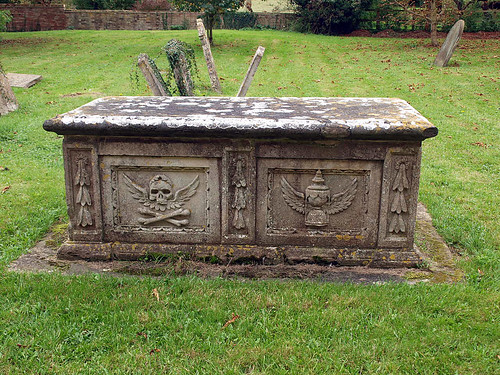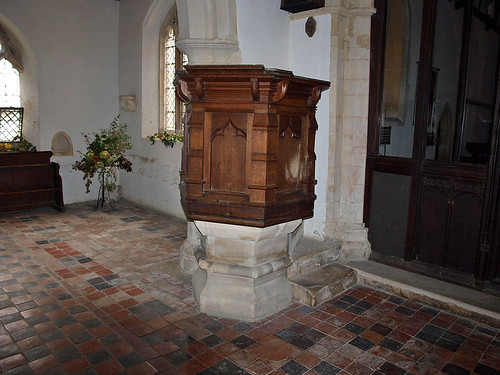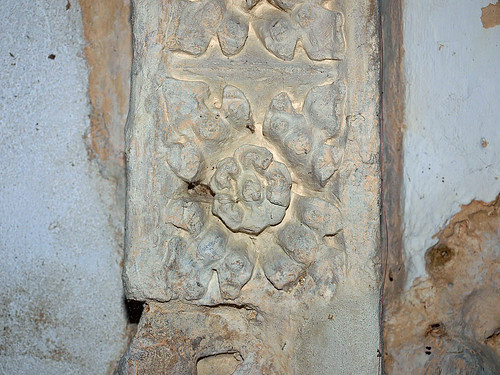ST MARGARET. Of brown cobbles; Dec and Perp. Dec the N aisle, according to the two-light windows with reticulation units, and the four-bay arcade with quatrefoil piers and thin shafts in the diagonals. Dec, though much restored, the S aisle too. The doorway anyway is reliable, and the S arcade with standard motifs looks in its detail even earlier than the N arcade. In the aisle is an ogee-headed recess with crockets and buttress-shafts. The long tendril with flowers in one moulding is reminiscent of Swineshead and Yelden in Bedfordshire. In the vestry W wall outside a re-set niche of very pretty details. Perp W tower, the figures of the pinnacles supposedly Elizabethan. The chancel is by Butterfield, 1861, with the N vestry and N porch, but there is nothing that could reveal him at once. - SCREEN. Under the tower arch. Partly (dado) Perp. - PAINTING. Interesting Flemish late C15 Adoration of the Magi. The scene is in demi-figures, which is rare. - STAINED GLASS. In the N aisle E window old bits. - The E window and the one N and two S windows in the chancel must be by Gibbs, Butterfield’s protégé. - PLATE. Cup of 1564-5, an early date.
ABBOTSLEY. Whoever comes here and looks up to the church tower’s battlemented parapet may see two enemies who fought in Scotland and two who fought in England. It is long since they drew their swords, and now they watch over this pleasant countryside, looking down on thatched cottages that have been here perhaps ten generations. They see manor farm and its 17th century dovecot, with old timbers and a tiled roof, all very quaint; they look beyond Caldecote Manor, with its moat still full of water, to a road the Romans made. Caesar’s men, the Conqueror, and a great page of Shakespeare we are moved to think of here.
Old houses gather round the church, finely placed on a little hill, its noble chancel arch 13th century and its font perhaps new when Bishop Grosseteste was rector here soon after Magna Carta. He was a brilliant scholar and a famous mathematician, and in his zeal for church reform he defied the Pope himself.
The graceful arcades are 14th century, and, though the roofs are modern, they are borne on stone angels that have been spreading their wings 600 years. There are more angels on 15th century brackets which may have been carved by the craftsman who made the beautiful niche in the vestry, and under the tower is a 16th century oak screen. On the altar is a 16th century Flemish painting on wood showing very serious Wise Men coming to worship the Holy Child, who is in the arms of a Madonna of rare charm.
One of the most beautiful things in the church is a magnificent tomb recess with an arch richly carved between canopied buttresses. Time has been unkind to it, but its exquisite roses and foliage, its wonderful little faces with tongues hanging out, make it a treasure of great price.
But we see the oddest things Abbotsley has to show from the churchyard where William Heylock has been lying under a quaintly carved tomb since 1688. The massive tower (with two bells still ringing in it older than the Spanish Armada) has stood here 600 years and has fierce gargoyles on the battlements as well as the four warrior kings on handsome pedestals, two modern and two perhaps 16th century. The modern figures stand for the Conqueror and our Saxon Harold, looking over the England one lost and the other won; and the old figures are said to be Macbeth and Malcolm, who met on that day when Birnam Wood came to Dunsinane. We may imagine that the schoolboys of Abbotsley like to look up to these four soldiers on their church tower and remember the great pages of history and literature in which they figure.
Old houses gather round the church, finely placed on a little hill, its noble chancel arch 13th century and its font perhaps new when Bishop Grosseteste was rector here soon after Magna Carta. He was a brilliant scholar and a famous mathematician, and in his zeal for church reform he defied the Pope himself.
The graceful arcades are 14th century, and, though the roofs are modern, they are borne on stone angels that have been spreading their wings 600 years. There are more angels on 15th century brackets which may have been carved by the craftsman who made the beautiful niche in the vestry, and under the tower is a 16th century oak screen. On the altar is a 16th century Flemish painting on wood showing very serious Wise Men coming to worship the Holy Child, who is in the arms of a Madonna of rare charm.
One of the most beautiful things in the church is a magnificent tomb recess with an arch richly carved between canopied buttresses. Time has been unkind to it, but its exquisite roses and foliage, its wonderful little faces with tongues hanging out, make it a treasure of great price.
But we see the oddest things Abbotsley has to show from the churchyard where William Heylock has been lying under a quaintly carved tomb since 1688. The massive tower (with two bells still ringing in it older than the Spanish Armada) has stood here 600 years and has fierce gargoyles on the battlements as well as the four warrior kings on handsome pedestals, two modern and two perhaps 16th century. The modern figures stand for the Conqueror and our Saxon Harold, looking over the England one lost and the other won; and the old figures are said to be Macbeth and Malcolm, who met on that day when Birnam Wood came to Dunsinane. We may imagine that the schoolboys of Abbotsley like to look up to these four soldiers on their church tower and remember the great pages of history and literature in which they figure.



No comments:
Post a Comment